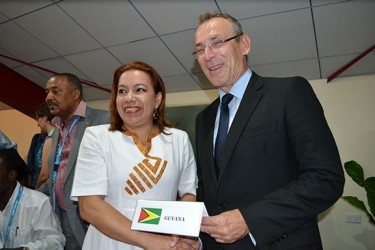European Commissioner for Development Andris Piebalgs yesterday signed development programmes for 21 African, Caribbean and Pacific (ACP) group countries and Guyana’s allocation is Euros 34 Million ($9.28B) over the next seven years.
A release from the European Union yesterday said that the funds for Guyana will focus mainly on climate change adaptation and disaster risk reduction, including sea defences. The agreement was signed in the Pacific Ocean island of Samoa.
The funds have been allocated to the countries’ National Indicative Programmes under the 11th European Develop-ment Fund (EDF) for the period 2014-2020.

Minister of Foreign Affairs, Carolyn Rodrigues-Birkett signed the deal with Pielsbag on behalf of Guyana.
The signing occurred on the sidelines of the UN Third International Conference on Small Island Developing States. Aside from Guyana, the signatory countries from the Caribbean are Antigua and Barbuda, Barbados, Dominica, Grenada, Jamaica, St Kitts and Nevis, St Lucia, St Vincent and the Grenadines and Trinidad and Tobago.
After the signing ceremony, Piebalgs said: “Today’s signatures mark the official go-ahead to continue strengthening our development cooperation with the concerned countries. These documents lay down the priorities for our joint work for the next seven years and will allow us to move ahead with the preparations of the concrete projects and programmes.”
He added “For the European Union it is essential that our programmes are drawn up in close cooperation with our partner countries, based on governments’ own policies and strategies and reflecting their stated needs. This is how we ensure that programming documents really support areas where the EU can add value”.
EU Member States agreed in 2013 the overall amount for development cooperation that will be directed to 78 ACP countries through the 11th EDF. The National Indicative Programmes that were signed yesterday define the strategy and priorities for EU aid in each particular country and were done in close cooperation with the partner countries.
One of the programmes that is likely to be financed for Guyana is the second phase of the Mahaica-Mahaicony-Abary Scheme.
Agriculture Minister Dr Leslie Ramsammy has mentioned the project twice in recent weeks and said it will be 30M Euros (US$41M).
While Phase Two of the MMA is still at the funding clearance and ministerial level, the National Drainage and Irrigation Authority has met with EU representatives, exchanging technical data on the contours of the project which straddles regions four and five.
Ramsammy had stated during the recent presentation of the 2013-2020 National Strategy for Agriculture that the first portion of the MMA-ADA Phase Two will take up to five years and should make available up to 200,000 acres of land in Mahaicony.
Part of the project will be the damming of the Mahaicony River which is expected to ease flooding in the area.
Phase two of the MMA project will focus on the Mahaicony area. Phase two and three of the project were to be completed decades ago, however only the Abary segment was ever completed. Critics say the Abary segment is not functioning the way it was intended and it may have to be reopened and re-engineered before the other phases are tackled.
Phases two and three are seen as critical to protecting Mahaicony and Mahaica from deep flooding and to open up more lands for rice farming.




